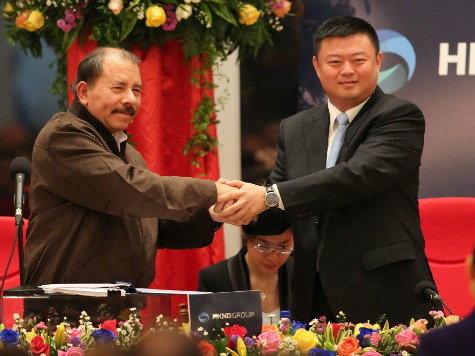
The “Interoceanic Grand Canal” (IGC) is about to be dug across Nicaragua to compete with the Panama Canal by as early as 2019.
The Sandinista government of Nicaragua’s President Daniel Ortega granted a 100-year concession to the Hong Kong Nicaragua Canal Development Investment Company (HKND). The IGC will cut more than 1,000 miles and a day’s time off trips by supertankers, giant container ships, and potentially Chinese warships to connect from the Pacific Ocean to the Caribbean.
As the poorest nation in the western hemisphere except for Haiti, Nicaragua sees the project as a spectacular economic boost. The Chinese not only see the canal as a medium for trade, but also as a way to push back against Washington’s militarized “Pacific Pivot” and Trans-Pacific Partnership that seeks to contain China’s global economic and military power.
The idea of constructing a man-made waterway across Central America originated with the 17th Century “New Spain” colonial authorities. Preliminary surveys of routes were suggested across Nicaragua, Panama, and the Isthmus of Tehuantepec in Mexico. The newly independent Federal Republic of Central America in 1825 considered a waterway financed by the United States to travel 172.7 miles from the Caribbean, up the San Juan River, across Lake Nicaragua, and then through a series of locks and tunnels to the Pacific Ocean. The project dribbled along for 79 years until the U.S. took over the bankrupt Panama Canal project in 1904 after a 23-year French construction effort.
HKND is led by 41-year-old Wang Jing. He is not very well known in China and was virtually invisible to the American press prior to the IGC approval. In an interview with the Financial Times last year, he called himself a “very ordinary Chinese citizen” who lives with his mother, younger brother, and daughter in Beijing.
However, Wang Jing’s bio on HKND’s website says he is the “Board Chairman of more than 20 enterprises which operate businesses in 35 countries.” In the last three years, Xinwei Telecom Enterprise Group supposedly became one of the fastest growing telecommunications companies in the world. The company’s spirit of “Optimism, Diligence, Pragmatism and Innovation” was initiated by Mr. Wang Jing.
Under the agreement with the Nicaraguan government, HKND would raise the $40 billion needed to build the canal and gain the right to operate and manage the joint venture for up to 100 years. The Nicaraguan government claims the IGC canal project will double the national economy, triple employment, and lift more than 400,000 people out of poverty by 2018. The construction would also be a boon to global trade by allowing access for colossal supertankers and container ships that are too wide to transit the aging Panama Canal 500 miles the south.
Wired magazine in February did an exposé on the fact that HKND was the only company allowed to bid on the project. Jorge Huete-Pérez, President of Nicaraguan Academy of Sciences, said Nicaraguan law requires any “major infrastructure project you have to place bids, that is the law.” He also notes, “Here they overlooked the law and chose this company that has no experience building infrastructure.”
Wang Jing is a substantial businessman, but where the money to build the canal will come from is still a mystery. He has denied the Chinese government is involved in the project, as have government officials, but U.S. security analysts suspect otherwise.
According to Foreign Policy In Focus, the canal is “a way for China to push back against Washington’s militarized ‘Pacific Pivot,’ as well as the U.S. drive to establish a Trans-Pacific Strategic Economic Partnership” (TPP) that seeks to contain China’s global economic and military growth.
The TPP is a U.S.-led free trade agreement that is being secretly written. WikiLeaks recently exposed to the public a partial draft devised by 12 Pacific Rim governments and 600 of the world’s largest corporations setting rules for investment and trade in the 21st century. Unless China adopts rules that will rewrite its regulatory and investment laws to curtail state-owned investments and open its state-owned enterprises to Wall Street investment rules, China will be excluded from free trade with TPP members.
Due to its increased shipping of resources and goods, China has emerged as the new center for global manufacturing and investment. China’s container traffic equals more than 5,000 transits a year, with hauls exceeding 10,000 gross tons per ship. According to World Bank data, Chinese container traffic is nearly three times U.S. traffic.
China’s success in regional and global trade has given it the economic and fraternal clout to partner with the other ex-colonial and ex-socialist emerging economies to provide a competing model to the United States “neo-liberal” TPP trade block. The supposedly Sandinista “reformed Marxist” Nicaragua is a prime example of that fraternity.
A Chinese-led Nicaragua Canal challenges America’s 150-year-old claim of military and economic hegemony in the western hemisphere, as outlined in the Monroe Doctrine. The United States invaded in 1912 and occupied Nicaragua until 1933. From 1979 to the early 1990s, the United States funded the Contra guerillas that fought against Daniel Ortega after his Marxist Sandinistas toppled a U.S. backed Nicaraguan government.
With the United States attempting to reassert its Pacific Rim hegemony, China looks to strategically retaliate by building the only canal that colossal supertankers, container ships, and potentially even Chinese aircraft carriers can transit from the Pacific Ocean to the Caribbean Sea.
The author welcomes feedback and will respond to comments by readers.

COMMENTS
Please let us know if you're having issues with commenting.